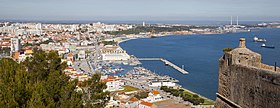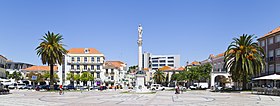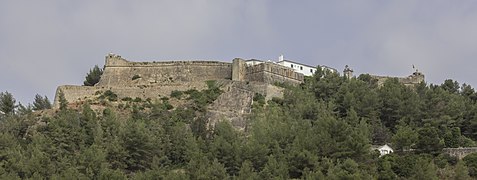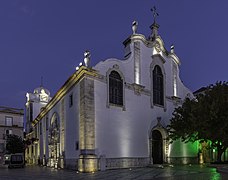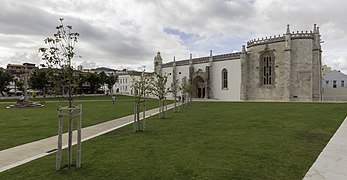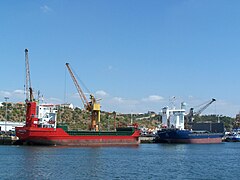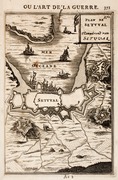Setúbal
Setúbal | |
|---|---|
|
Clockwise: View of Setúbal from Castelo de São Filipe; Bocage Gardens; Santa Maria da Arrábida Fort; Praça do Bocage; São Julião Church; view of Setúbal from the Sado Estuary. | |
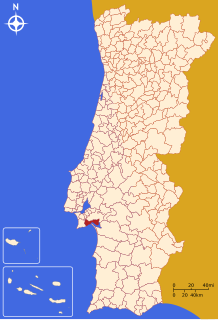 | |
| Coordinates: 38°31′27.5″N 8°53′33.4″W / 38.524306°N 8.892611°W | |
| Country | |
| Region | Lisbon |
| Metropolitan area | Lisbon |
| District | Setúbal |
| Parishes | 5 |
| Government | |
| • President | André Martins (CDU) |
| Area | |
| • Total | 230.33 km2 (88.93 sq mi) |
| Population (2014) | |
| • Total | 118,166 |
| • Density | 510/km2 (1,300/sq mi) |
| Time zone | UTC±00:00 (WET) |
| • Summer (DST) | UTC+01:00 (WEST) |
| Local holiday | 15 September |
| Website | www |
Setúbal (/səˈtuːbəl/ sə-TOO-bəl,[1][2] US also /-bɑːl/ -bahl,[3] European Portuguese: [sɨˈtuβal] ; Proto-Celtic: *Caetobrix) is a city and a municipality in Portugal. The population of the entire municipality in 2014 was 118,166,[4] occupying an area of 230.33 km2 (88.9 sq mi).[5] The city itself had 89,303 inhabitants in 2001.[6] It lies within the Lisbon metropolitan area, about 50 kilometres (31 miles) from Lisbon downtown by road.
In the times of Al-Andalus, the city was known as Shaṭūbar (Andalusian Arabic: شَطُوبَر [ʃeˈtˤuːbɑr]), after the old pre-Roman name of Cetobriga. In the 19th century, the port was called Saint Ubes in English,[7] and Saint-Yves in French.
The municipal holiday is 15 September, which marks the date in 1860 when King Pedro V of Portugal officially recognised Setúbal as a city.
City information
[edit]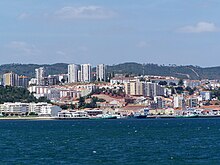
The city of Setúbal is located on the northern bank of the Sado River estuary, approximately 48 kilometres (30 miles) south of Portugal's capital, Lisbon. It is also the seat of the Setúbal District and formerly in the historic Estremadura Province.
In the beginning of the 20th century, Setúbal was the most important center of Portugal's fishing industry, particularly specializing in processing and exporting sardines. None of the many factories then created are operating today. However, the existing maritime ports, either traditional, commercial and the new marines, keep the city's links to the ocean and water well alive and vibrant. Tourism, based on the beautiful natural conditions plus excellent hotels, resorts and infrastructures, is one of the city's most appreciated resources, due to its interconnection with the Sado (river) on one side and Atlantic Ocean on another, having a coast line with both. The city is also connected with the nearby coast of the Arrábida hills natural park - which offers an unspoiled nature and beautiful beaches to the Atlantic Ocean. A dolphin colony inhabits the Sado River. Across the river on the south bank lies the peninsula of Tróia, a place with vast white/golden sand beaches where several luxury hotels and resorts were recently built. The Tróia peninsula can be sighted from the city, across the river. Albarquel, Figueirinha, Galápos, Galapinhos, Creiro and Portinho da Arrábida are some of the city's many beaches, located in the north bank of the estuary, at the very beginning of the Arrábida hills.
History
[edit]In antiquity the city was known as Cetobriga, a Turdetani settlement that came under Roman control in the province of Lusitania.
Culture
[edit]
The main historical monument of the city of Setúbal is the Monastery of Jesus, which is a 15th- and 16th-century church that represents one of the first buildings in the Portuguese late Gothic style known as Manueline.
The Roman Catholic Church has a diocese, the Roman Catholic Diocese of Setúbal, headquartered in the city, with its see (seat of the bishop) at the Our Lady of Grace Cathedral, Setúbal, famous for its Mannerist façade.
Also of interest are the São Julião Church, also with Manueline portals. The Castelo de São Filipe, is a 16th- and 17th-century fortress on the north bank of the Sado river, overseeing the city. The fortress was converted into a luxury hotel (pousada).
Teatro Animação de Setúbal is based in Setúbal.
Demography (municipality)
[edit]| Year | 1801 | 1849 | 1900 | 1930 | 1960 | 1981 | 1991 | 2001 | 2011 | 2014 |
|---|---|---|---|---|---|---|---|---|---|---|
| Population | 15,442 | 15,060 | 35,990 | 50,456 | 56,344 | 98,366 | 103,634 | 113,934 | 121,061 | 118,428 |
Civil Parishes
[edit]
Administratively, the municipality is divided into five civil parishes (freguesias):[9]
- Azeitão (São Lourenço e São Simão)
- Gâmbia – Pontes – Alto da Guerra
- Sado
- São Julião, Nossa Senhora da Anunciada e Santa Maria da Graça
- São Sebastião
Climate
[edit]Setúbal has a Mediterranean climate (Köppen: Csa) with mild, rainy winters and warm to hot, dry summers. Temperatures in the winter vary between 15 and 17 °C (59 and 63 °F) during the day and 5–8 °C (41–46 °F) at night, most of the precipitation (starting from November) falls in this season. Temperatures in the summer vary between 27 and 30 °C (81 and 86 °F) during the day and 15 and 17 °C (59 and 63 °F) at night, precipitation is scarce during this season. The average annual temperature varies between 16.5 and 17 °C (61.7 and 62.6 °F).
On 4 August 2018, Setúbal registered a record high temperature of 45.5 °C (113.9 °F)[10] which, according to weather records expert Maximiliano Herrera, was the highest temperature ever recorded on the coast of the Iberian Peninsula.[11]
| Climate data for Setúbal (Varzinha orchard station) 1981–2010, extremes (1971-present) | |||||||||||||
|---|---|---|---|---|---|---|---|---|---|---|---|---|---|
| Month | Jan | Feb | Mar | Apr | May | Jun | Jul | Aug | Sep | Oct | Nov | Dec | Year |
| Record high °C (°F) | 24.2 (75.6) |
25.0 (77.0) |
30.2 (86.4) |
34.4 (93.9) |
36.7 (98.1) |
42.2 (108.0) |
44.3 (111.7) |
45.5 (113.9) |
42.1 (107.8) |
35.8 (96.4) |
28.8 (83.8) |
22.9 (73.2) |
45.5 (113.9) |
| Mean daily maximum °C (°F) | 15.3 (59.5) |
16.7 (62.1) |
19.4 (66.9) |
20.5 (68.9) |
23.4 (74.1) |
27.4 (81.3) |
29.9 (85.8) |
30.1 (86.2) |
27.8 (82.0) |
23.3 (73.9) |
18.8 (65.8) |
15.9 (60.6) |
22.4 (72.3) |
| Daily mean °C (°F) | 10.1 (50.2) |
11.3 (52.3) |
13.5 (56.3) |
14.8 (58.6) |
17.4 (63.3) |
20.9 (69.6) |
23.1 (73.6) |
23.2 (73.8) |
21.3 (70.3) |
17.9 (64.2) |
13.9 (57.0) |
11.3 (52.3) |
16.6 (61.8) |
| Mean daily minimum °C (°F) | 4.8 (40.6) |
5.8 (42.4) |
7.6 (45.7) |
9.1 (48.4) |
11.4 (52.5) |
14.3 (57.7) |
16.2 (61.2) |
16.3 (61.3) |
14.8 (58.6) |
12.4 (54.3) |
9.0 (48.2) |
6.6 (43.9) |
10.7 (51.2) |
| Record low °C (°F) | −5.1 (22.8) |
−4.6 (23.7) |
−2.5 (27.5) |
−0.7 (30.7) |
3.0 (37.4) |
5.4 (41.7) |
7.9 (46.2) |
8.5 (47.3) |
6.8 (44.2) |
2.0 (35.6) |
−2.4 (27.7) |
−4.1 (24.6) |
−5.1 (22.8) |
| Average precipitation mm (inches) | 98.4 (3.87) |
75.3 (2.96) |
53.3 (2.10) |
66.7 (2.63) |
48.5 (1.91) |
16.8 (0.66) |
3.7 (0.15) |
3.7 (0.15) |
27.2 (1.07) |
97.6 (3.84) |
119.4 (4.70) |
124.7 (4.91) |
735.3 (28.95) |
| Source: Instituto Português do Mar e da Atmosfera[12] | |||||||||||||
| Climate data for Setúbal, Sado Estuary Natural Reserve (Lisnave), 1971–2000 normals and extremes | |||||||||||||
|---|---|---|---|---|---|---|---|---|---|---|---|---|---|
| Month | Jan | Feb | Mar | Apr | May | Jun | Jul | Aug | Sep | Oct | Nov | Dec | Year |
| Record high °C (°F) | 21.3 (70.3) |
25.0 (77.0) |
29.5 (85.1) |
32.6 (90.7) |
36.0 (96.8) |
38.0 (100.4) |
43.6 (110.5) |
39.5 (103.1) |
39.0 (102.2) |
31.5 (88.7) |
28.5 (83.3) |
23.0 (73.4) |
43.6 (110.5) |
| Mean daily maximum °C (°F) | 15.4 (59.7) |
16.5 (61.7) |
19.2 (66.6) |
19.9 (67.8) |
22.3 (72.1) |
26.1 (79.0) |
28.8 (83.8) |
28.9 (84.0) |
26.5 (79.7) |
22.7 (72.9) |
18.9 (66.0) |
16.2 (61.2) |
21.8 (71.2) |
| Daily mean °C (°F) | 10.9 (51.6) |
12.2 (54.0) |
14.2 (57.6) |
15.4 (59.7) |
17.6 (63.7) |
20.6 (69.1) |
22.8 (73.0) |
22.9 (73.2) |
21.3 (70.3) |
18.0 (64.4) |
14.4 (57.9) |
12.1 (53.8) |
16.9 (62.4) |
| Mean daily minimum °C (°F) | 6.5 (43.7) |
7.9 (46.2) |
9.2 (48.6) |
10.9 (51.6) |
12.9 (55.2) |
15.2 (59.4) |
16.8 (62.2) |
16.9 (62.4) |
16.1 (61.0) |
13.2 (55.8) |
9.9 (49.8) |
8.0 (46.4) |
12.0 (53.5) |
| Record low °C (°F) | −2.0 (28.4) |
−0.1 (31.8) |
1.0 (33.8) |
3.5 (38.3) |
6.0 (42.8) |
9.5 (49.1) |
10.5 (50.9) |
10.0 (50.0) |
9.5 (49.1) |
3.2 (37.8) |
1.0 (33.8) |
−1.0 (30.2) |
−2.0 (28.4) |
| Average rainfall mm (inches) | 74.0 (2.91) |
65.3 (2.57) |
33.7 (1.33) |
53.6 (2.11) |
35.1 (1.38) |
11.4 (0.45) |
4.1 (0.16) |
3.2 (0.13) |
24.4 (0.96) |
73.8 (2.91) |
85.7 (3.37) |
95.5 (3.76) |
559.8 (22.04) |
| Average precipitation days (≥ 0.1 mm) | 10.5 | 10.7 | 7.0 | 10.6 | 7.7 | 3.1 | 1.0 | 1.1 | 4.0 | 8.8 | 9.7 | 12.3 | 86.5 |
| Source: Instituto Português do Mar e da Atmosfera[13] | |||||||||||||
Economy
[edit]According to the census of 2011, the municipality of Setúbal had a labor force of 58,514 people, among whom 15.6% were unemployed. Among those who had a job, 1.6% were working in the Primary sector, 24.9% in the Secondary sector and 73.5% in the Tertiary sector.[14] Setúbal is notable for the industries of pulp, paper, cement, fertilizers, pesticides, other phytopharmaceutical products, thermal power, shipbuilding and ship repair there was a lot of automobile assembling industry since the 1950s with several known manufacturers had or have opened assembly halls for the Portuguese market. Today there are only 3 tradenames nearby currently in production. The Port of Setúbal had a cargo throughput of 6.058 million tons in 2012,[15] making it the 4th busiest port in Portugal, with 7.4% of the cargo throughput in the country.[16] In the 19th century, the area was notable for the production of sea salt. St. Ubes bay salt was exported as far as Australia in the 1830s.[17]
Education
[edit]This section needs expansion. You can help by adding to it. (February 2023) |
Transportation
[edit]Setúbal has a train station, Praça do Quebedo station, with regional and commuter trains every hour on weekdays (and every half-hour during rush hour) to Entrecampos railway station in Lisbon, with daily connections to Santa Apolónia railway station, and transfers from there to other cities in Portugal, including Sintra and Póvoa. There is also a train line south to Faro, with twice-daily service, and a connection eastward to Ebora, five times daily.
In the past, in the municipality there was also the Santiago do Cacém railway station, which operated from 1933 through the 1980s.
In addition, there are local buses and a network of highways and secondary roads in and around the city.
Sports
[edit]The city's main sports club is Vitória de Setúbal, the football club established on 20 November 1910.

Notable residents and citizens
[edit]Public Service
[edit]
- Diogo Fernandes Pereira (ca.15C-ca.16C) a 16th-century navigator; in 1503 the first European captain to visit the island of Socotra and discovered the Mascarenes archipelago (Réunion, Mauritius, and Rodrigues) in 1507
- José Travassos Valdez, 1st Count of Bonfim (1787–1862) soldier, politician, Prime Minister of Portugal, 1839 to 1841
- Rui Machete (born 1940) a Portuguese politician and Govt. minister
Religion
[edit]- Dom Américo Aguiar is a Cardinal-elector of the Roman Catholic Church, and bishop of the Roman Catholic Diocese of Setúbal, who is resident at the Our Lady of Grace Cathedral, Setúbal
The Arts
[edit]
- Manuel Maria Barbosa du Bocage (1765–1805) notable satirical and classical poet.
- Luisa Todi (1753–1833) a Portuguese mezzo-soprano opera singer
- João Vaz (1859-1931) a painter and decorator who specialized in maritime subjects.
- Roy Campbell (1901–1957) a South African poet, died nearby in a car accident.
- Sebastião da Gama (1924–1952) a Portuguese poet, he wrote about the Arrábida Natural Park
- Lima de Freitas (1927–1998) Portuguese painter, illustrator, ceramicist and writer.
- Zeca Afonso (1929-1987) singer and songwriter, lived, worked and died in the city
- Manuela Couto (born 1964) a Portuguese actress on TV, cinema and theatre.[18]
- Luís Buchinho (born 1969) a Portuguese fashion designer.
- Roman Konoplev (born 1973) a Russian and Transnistrian writer and publicist.
- Mazgani (born 1974) an Iranian-Portuguese singer-songwriter.
- Sofia Vitória (born 1979) singer of Jazz & World Music
- Sabrina (born 1982) represented Portugal at the Eurovision Song Contest 2007.
- Cátia Mazari Oliveira (born 1983) better known by her artistic name A Garota Não, a Portuguese singer-songwriter.
- André Marques (born 1984) writer and director.[19]
- Filipa Barroso, (Wiki PT) (born 1998) model and Miss Portuguesa 2017
- Matilde Lima, (Wiki PT) (born 1999) model and Miss Universo Portugal 2017
Sport
[edit]
- Francisco Santos (footballer) (1904 - ?)
- Oceana Zarco (1911–2008) first Portuguese female professional cyclist, in 1925
- Jaime Graça (1942–2012) a footballer and coach with 303 club caps and 36 for Portugal
- Silvino Louro (born 1959) a former footballer with 408 club caps and 23 for Portugal
- José Mourinho (born 1963) distinguished football manager.
- Fernando Mendes (born 1966) a former footballer with 350 club caps and 11 for Portugal
- Bruno Ribeiro (born 1975) a football manager and former player with 305 club caps
- Bruno Lage (born 1976) a football manager, head coach of Wolverhampton Wanderers F.C.
- Susana Costa (born 1984) a Portuguese athlete specialising in the triple jump
- Marco Soares (born 1984) a footballer with over 370 club caps and 49 for Cape Verde
- José Semedo (born 1985) a former footballer with 466 club caps and 11 for Portugal U-21
International relations
[edit]Setúbal is twinned with:
|
Setúbal has international cooperation protocols with:
|
Gallery
[edit]-
São Julião Church in central Setúbal.
-
Monastery of Jesus of Setúbal (15th and 16th centuries).
-
Cruzeiro (a Stone cross) and façade of the Monastery of Jesus of Setúbal.
-
Main entrance to the Gothic-Manueline Monastery of Jesus of Setúbal.
-
A view of Setúbal's seaport.
-
Jardim Bonfim park.
-
Largo da Misericórdia.
-
Fortifications of Setúbal. Manesson Mallet: Travaux de Mars ou l'Art de la Guerre.
See also
[edit]References
[edit]- ^ "Setúbal". The American Heritage Dictionary of the English Language (5th ed.). HarperCollins. Retrieved 5 May 2019.
- ^ "Setúbal". Oxford Dictionaries UK English Dictionary. Oxford University Press.[dead link]
- ^ "Setúbal". Merriam-Webster.com Dictionary. Merriam-Webster. Retrieved 5 May 2019.
- ^ "Statistics Portugal". www.ine.pt. Archived from the original on 28 November 2017. Retrieved 3 May 2018.
- ^ "Áreas das freguesias, concelhos, distritos e país". Archived from the original on 2018-11-05. Retrieved 2018-11-05.
- ^ UMA POPULAÇÃO QUE SE URBANIZA, Uma avaliação recente – Cidades, 2004 Archived 2014-10-06 at the Wayback Machine Nuno Pires Soares, Instituto Geográfico Português (Geographic Institute of Portugal)
- ^ Wedgwood, Hensleigh (1855). "On False Etymologies". Transactions of the Philological Society (6): 67.
- ^ "PORDATA - Base de Dados dos Municípios". www.pordata.pt. Archived from the original on 23 October 2017. Retrieved 3 May 2018.
- ^ Diário da República. "Law no. 11-A/2013, page 552 114" (PDF) (in Portuguese). Retrieved 31 July 2014.
- ^ "August 2018 bulletin" (PDF). IPMA. Retrieved 29 September 2021.
- ^ Jeff Masters. "Heat Wave Smashes All-Time Heat Records in Portugal and Spain". www.wunderground.com. Retrieved 29 September 2021.
- ^ "Normal Climatológica – Setúbal / Estação de Fruticultura 1981-2010" (PDF). IPMA. Retrieved 15 February 2022.
- ^ "Monthly Averages for Setúbal (Setenave) (1971–2000)" (PDF). IPMA.
- ^ "Municípios - Emprego e Mercado de Trabalho" (in Portuguese). PORDATA Base de Dados Portugal Contemporâneo. Archived from the original on 27 August 2013. Retrieved 8 September 2013.
- ^ "2012-Estatísticas" (in Portuguese). Porto de Setúbal - APSS, SA. Archived from the original on 4 October 2013. Retrieved 8 September 2013.
- ^ "INE: Porto de Lisboa perdeu 30% do movimento de mercadorias" (in Portuguese). Diário Económico. Archived from the original on 5 October 2013. Retrieved 8 September 2013.
- ^ "Classified Advertising". Sydney Gazette and New South Wales Advertiser. 21 June 1831.
- ^ Manuela Couto, IMDb Database retrieved 28 June 2021.
- ^ André Marques, IMDb Database retrieved 28 June 2021.
Bibliography
[edit]External links
[edit]- Town Hall official website
- O Bocagiano Local News
- Setúbal na Rede is a pioneering project, innovative and the first digital-only newspaper in Portugal.
- Setúbal Walking Tour (Youtube)
- Largo De Jesus to Train Station Walking Tour (Youtube)
- Fishing Port to Albarquel Park Walking Tour (Youtube)
- Viewpoint Of S. Sebastião, Praça Do Quebedo Walking Tour (Youtube)
- Abandoned Boats In Setúbal (Youtube)
 Media related to Setúbal at Wikimedia Commons
Media related to Setúbal at Wikimedia Commons

